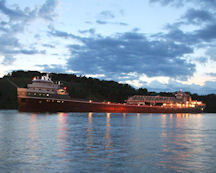By tradition, ships are always female. And the best-dressed ships are the ones that carry passengers on multi-day trips.
Roland and I toured the S.S. Keewatin while our own boat was docked in Douglas, Michigan. (S.S. stands for steamship.) The Keewatin carried passengers across the Great Lakes from 1908 through 1965 and is now a museum.
The Canadian Pacific Railroad commissioned and operated the Keewatin. The company had railroad terminals at ports along Lake Superior and later on Lake Huron's Georgian Bay. The most direct route between them was over the water, but nobody could figure out how to lay tracks there. So the company had the Keewatin built to transport passengers from one terminal to another.
What did Roland and I learn from our tour of the passenger ship? First, we learned that people can do the seemingly impossible if they plan well enough. The Keewatin was built in Scotland for use on the Great Lakes, but there was a problem. The Canadian Pacific Railroad wanted a 350-foot boat. That made it too long to fit through the Welland Canal, which connected Lake Ontario with Lake Erie, so each half was built to float on its own. When the Keewatin reached the canal, workmen cut it in two. Once the sections were safely in Lake Erie, workmen re-joined the halves. This 1907 picture shows the midsection while the two halves were separated.
Second, the Keewatin told us that people haven't changed much in 100 years. We still like to relax in luxury while traveling, and the Keewatin's public areas look a lot like today's cruise ships. Here are two pictures.* (And no, that isn't a ghost in the dining room. It's just a headless mannequin dressed as a waiter.)
On the other hand, the cabins weren't as roomy as we expect today. Here is a Keewatin stateroom.
Like lighthouses, ships have their own personalities. One unique feature of the Keewatin is this planter . . .
that becomes a ceiling for the hallway below it.
The pots were nailed down to keep them from falling on unsuspecting passengers in rough seas. Still, I don't want to be underneath when the plants are being watered.
If you find yourself in the Saugatuck-Douglas area, be sure to see this grand old lady.
__________
* All pictures in this post are copyright 2011 by Kathryn Page Camp. The original picture of the Keewatin cut in two was taken in 1907 and is in the public domain.



































